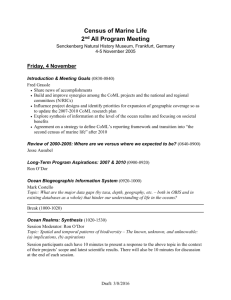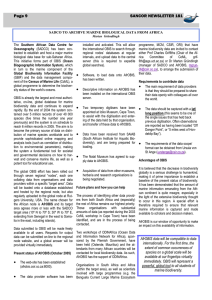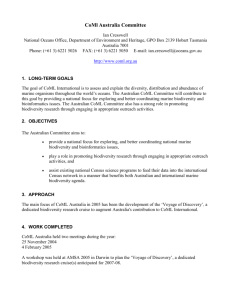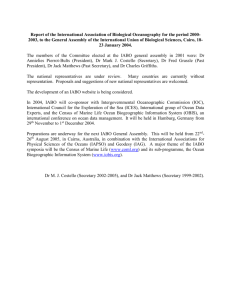The Census of Marine Life: R.K. O Dor , C.J. Decker
advertisement
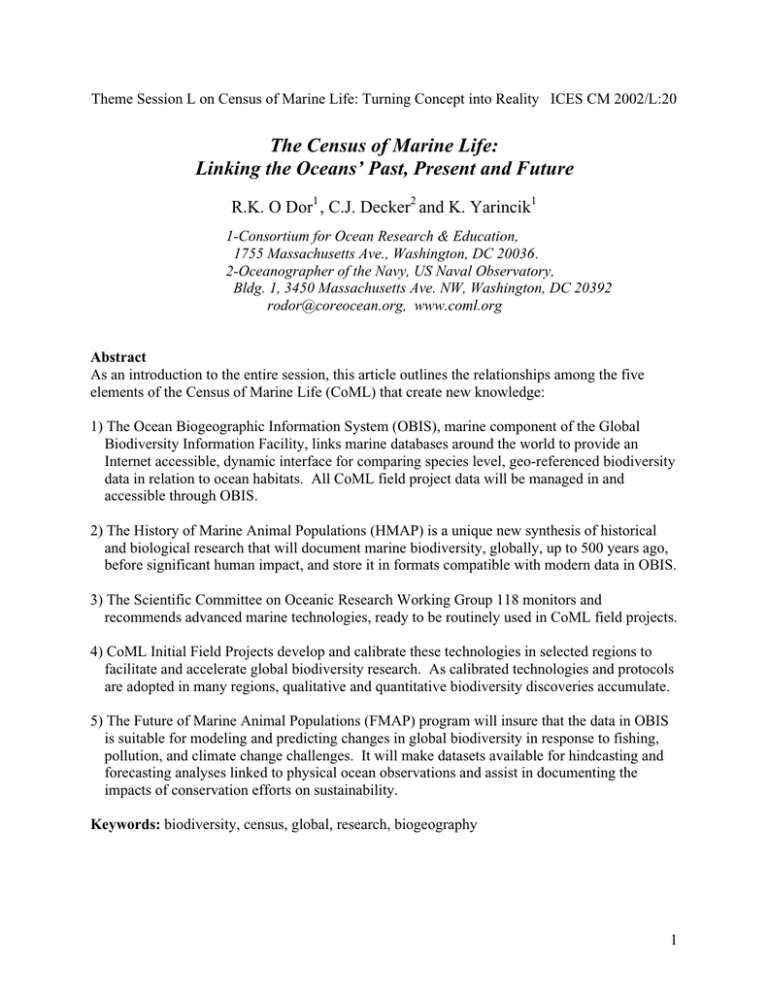
Theme Session L on Census of Marine Life: Turning Concept into Reality ICES CM 2002/L:20 The Census of Marine Life: Linking the Oceans’ Past, Present and Future R.K. O Dor1 , C.J. Decker2 and K. Yarincik1 1-Consortium for Ocean Research & Education, 1755 Massachusetts Ave., Washington, DC 20036. 2-Oceanographer of the Navy, US Naval Observatory, Bldg. 1, 3450 Massachusetts Ave. NW, Washington, DC 20392 rodor@coreocean.org, www.coml.org Abstract As an introduction to the entire session, this article outlines the relationships among the five elements of the Census of Marine Life (CoML) that create new knowledge: 1) The Ocean Biogeographic Information System (OBIS), marine component of the Global Biodiversity Information Facility, links marine databases around the world to provide an Internet accessible, dynamic interface for comparing species level, geo-referenced biodiversity data in relation to ocean habitats. All CoML field project data will be managed in and accessible through OBIS. 2) The History of Marine Animal Populations (HMAP) is a unique new synthesis of historical and biological research that will document marine biodiversity, globally, up to 500 years ago, before significant human impact, and store it in formats compatible with modern data in OBIS. 3) The Scientific Committee on Oceanic Research Working Group 118 monitors and recommends advanced marine technologies, ready to be routinely used in CoML field projects. 4) CoML Initial Field Projects develop and calibrate these technologies in selected regions to facilitate and accelerate global biodiversity research. As calibrated technologies and protocols are adopted in many regions, qualitative and quantitative biodiversity discoveries accumulate. 5) The Future of Marine Animal Populations (FMAP) program will insure that the data in OBIS is suitable for modeling and predicting changes in global biodiversity in response to fishing, pollution, and climate change challenges. It will make datasets available for hindcasting and forecasting analyses linked to physical ocean observations and assist in documenting the impacts of conservation efforts on sustainability. Keywords: biodiversity, census, global, research, biogeography 1 1. INTRODUCTION By the latter half of the 1990 s it had become clear that oceans, routinely treated as limitless sources and sinks for human consumption and waste, were changing in response to intense fishing, pollution, and climate change (NRC, 1995). Recognition that science has sampled less than 0.1% of the volume of the oceans led to the convening of a series of workshops focused on the question of whether it is possible to document what lives there, so that the changes can be monitored and understood (Ausubel, 1999). The outcome was a recommendation for a comprehensive international research program called the Census of Marine Life (CoML). The purpose of the CoML is to assess and explain the diversity, distribution and abundance of marine organisms throughout the world s oceans (Ausubel, 2001). It is organized around the questions: What did live in the oceans? What does live in the oceans? What will live in the oceans? The oceans occupy over 70% of the Earth s surface and 90% of the volume of its biosphere; documenting the life that exists in this part of the planet is a huge challenge. The two hundred scientists who participated in the workshops, however, agreed that new technologies available at the turn of the millennium have made it plausible to ask and answer these questions. Although the precision of the census cannot be predetermined and costs are estimated to be in the billiondollar range, major advances are possible on a schedule that can contribute usefully to the knowledge base necessary to manage an environment under increasing pressure. The detailed collaborative planning approach integral to the program seeks to assemble what is known, assess what is knowable and avoid quixotic detours into the unknowable. It has also become clear that, while costs for new research are significant, especially on a global scale, a great deal of sampling is already being done. In addition to existing international and governmental monitoring programs, industries such as transportation, fishing, oil exploration and mining are sampling the oceans in a variety of ways on a continuous basis. The real key to conducting an assessment of life in the oceans is cooperation and collaboration among scientists and stakeholders, together with the use of computer and internet technology to bring global data and expertise together. In 1999, a group of ten senior marine scientists from around the world formed the Scientific Steering Committee (SSC) for the Census of Marine Life. This group agreed that the first steps in the creation of the Census of Marine Life were the assembly of existing data and the development of a data management system to make this information accessible to scientists around the world. The next step was the development of a series of field studies to collect new information on life in the oceans. Finally, the use of these new and historical data will be combined with mathematical ecosystem models to provide predictions of the future state of marine communities. In order to assemble data on marine organisms before the era of modern fisheries management, the CoML initiated a project called the History of Marine Animal Populations (HMAP). Historians, anthropologists, and biologists formed an international consortium to rescue historical records of distribution and abundance. This rescued history will create a new vision of ocean life as it existed before major human impacts and will provide a historical context for new information collected. 2 At the same time, the CoML established the Ocean Biogeographic Information System (OBIS), ultimately a massive global network of interoperable databases. This internet-based, distributed system will be able to access not only species-level maps of the distribution and abundance of living organisms but also of the chemical and physical characteristics of the environment in which they live. The SSC also initiated development of a series of field projects (figure 1), designed to demonstrate new quantitative approaches for sampling a full spectrum of life forms in the major ocean habitats. Seven of these are now underway and several will contribute to this seession. All of the data from these projects will be assembled in and made available through OBIS. These projects are the initial phase in a series of projects to be conducted worldwide in a variety of habitats. Figure 1. Global distribution of the seven planned CoML demonstration projects. Symbols indicate site of CoML workshops and meetings. The project Natural Geography In Shore Areas (NaGISA), first developed in the western Pacific, is intended to develop a simple, standardized approach to describe the biodiversity from the shore to a depth of ten meters at selected reference sites along coastlines. The goal is to eventually expand this project to similarly cover the millions of kilometers of coastline around the world. The coastal project in the Gulf of Maine (GoM) brings together teams of U.S. and Canadian scientists to develop an integrated view of marine life in an already well-studied marginal sea, taking advantage of advanced technologies and monitoring systems already operating there. The Mid-Atlantic Ridge Ecosystem project (MAR-ECO) is addressing the challenge of measuring diversity and abundance in the very deep water column over one of the largest 3 physical features in the ocean. This project will combine state-of-the-art sampling gear with high-resolution bathymetric surveys to characterize the communities and bottom topography along selected areas of the Ridge. The most recently discovered and poorly characterized ecosystems, associated with geologically defined deep-sea seeps and vents, are the targets for the Biogeography of Chemosynthetic Ecosystems project (ChEss). This study will examine already-discovered and new communities to form a global biogeographic understanding of their composition and distribution. The abyssal plains are the largest habitat on the planet and the least well known. The CoMLaffiliated project, Census of Diversity of Abyssal Marine Life (CeDAMar) will explore benthic life in the deep basins, beginning in the South Atlantic Ocean. The expedition DIVA-1 started the series with the bottom communities of the Angola Basin off of Southwest Africa. Checklists of new and known species from all taxonomic groups, bacteria to large macrofauna, such as sea cucumbers, fishes, and crabs, will be developed and stored in OBIS. The abyssal plains may be the last place where science can study biodiversity patterns before major human impacts are felt. Two projects in the Northeast Pacific use advanced telemetry techniques. These techniques make it possible for the animals themselves to report on their movements and the rapidly changing environments in which they live and on whose associated organisms they depend. The Pacific Ocean Salmon Tracking (POST) project uses coded acoustic tags in animals as small as 25 grams to record migrations along the highly productive continental shelf of western Canada and the U.S. The Tagging of Pacific Pelagics (TOPP) project uses satellite telemetry to track movements of large predators across the entire Pacific Ocean basin. These new approaches should make it possible to identify and sample biological hot spots and to estimate abundances on ocean scales from limited, but strategic, direct sampling. The CoML recognizes that there are already many organizations with responsibilities for managing ocean resources. Most have come to recognize the need for broader understanding of ecosystems to improve their ability to predict the biological impacts of climate change, harvesting and other human interventions. The final element in the CoML, the Future of Marine Animal Populations (FMAP), is focused on data management to maximize the coverage and precision of the data acquired through all elements of the program and to make available through OBIS the data and appropriate mathematical models such groups require. To have any hope of predicting the unknown future, models must be able to predict the known past, so OBIS will provide data and a testing ground for biodiversity hindcasting using these tools. 2. COOPERATION The oceans form a large global system in which processes are closely linked, physically and biologically. Understanding their biodiversity requires comprehensive coverage in space as well as time. The goal of global coverage is fundamental to the CoML concept, not just the dream of over-ambitious scientists. In order to achieve this goal, it is crucial that the CoML integrate with existing programs and form new cooperative efforts around the world to obtain the data needed to characterize life in the world s oceans. There are several key efforts that the CoML is building to accomplish this. 4 One is the assembly of or access to species-level biodiversity information already collected or being collected by national and intergovernmental organizations, industry, and other groups. A second effort is formation of national or regional committees for the CoML around the world to help develop and oversee the implementation of new field projects. Finally, the CoML is fostering rapid, efficient, quantitative sampling techniques to better reach areas of the oceans that haven t been well sampled before. The primary focus of the CoML is on documenting patterns of biodiversity throughout the world s oceans, concentrating on macro-fauna and habitats that are poorly sampled or not explored at all. However, CoML is fully aware that it must take full advantage of unique sampling opportunities to share collected material with other programs and that the information assembled in OBIS will have enduring value to other programs. The collaborations outlined below take advantage of these synergies, and have led to an increasing participation in the program by scientists from around the world (figure 2). 700 600 People 500 400 300 200 100 0 1997 1998 1999 2000 2001 2002 2003 Date (months) Figure 2. Growth of participation in the CoML program. 2.1. Access to Information In 2001 OBIS became the marine associate for Global Biodiversity Information Facility (GBIF), established in Copenhagen under the Organisation for Economic Cooperation and Development (OECD). In this role, OBIS will be the primary means of access to marine data for GBIF. Efforts to assemble and access fisheries data in OBIS are a major focus of this ICES session, and parallel efforts on Pacific species will be a part of CoML ongoing collaborations with the North Pacific Marine Science Organization (PICES). In addition to these two organizations, CoML is also preparing to enter a collaboration with the Fisheries section of the Food and Agriculture Organisation of the United Nations (FAO). These efforts with intergovernmental organizations should result in access to all the fisheries survey data available around the world. 5 To date the most successful collaboration that CoML has developed with industry and conservation groups has been a joint effort between the Oil and Gas Producers Association (OGP) Deep Water Environmental Taskforce and United Nations Environment Programme s World Conservation Monitoring Centre (WCMC). British Petroleum has agreed to provide all of its environmental data to the WCMC. The OBIS office is working to integrate the marine component of this with other databases in the system. In addition to the mutual benefit of sharing data, the protocols developed for deep-water sampling in the MAR-ECO project could also serve needs of the Taskforce. A CoML investigator recently illustrated the value of such data by discovering a new species of 10 m-long deep-sea squid from videos generated by the oil and gas industry from around the world (Vecchione et al., 2001). 2.2. Implementation Committees A worldwide research program aimed at collecting new information on marine species cannot be designed and implemented by a single central committee such as the SSC. Field programs must be developed on an ecosystem basis and funded at a local level. For that reason, the CoML is fostering the formation of implementation committees at two levels. First at the national level in countries with major ocean research capacity to establish project and funding priorities and second at the regional level to strengthen the collaborative efforts where large ocean areas are associated with countries having limited research capacity. Canada, with CoML field projects on both its Atlantic and Pacific coasts, held a workshop in February 2002 to form a national committee. The major products were a review of existing biodiversity information in three oceans to meet commitments to the UN Convention on Biological Diversity and a commitment to incorporate the Department of Fisheries and Oceans Canada (DFO) long-term survey data into OBIS. Processes for the formation of CoML national committees are underway in the USA, the European Union, Japan and Australia. The most advanced regional committee process has evolved from the joint meeting of the International Association for Biological Oceanography (IABO) and the International Association for the Physical Sciences of the Ocean (IAPSO). This meeting took place in Mar del Plata, Argentina in October 2001. A CoML Symposium there laid groundwork for a South American workshop in Concepcion, Chile, jointly sponsored by CoML and Partnership for Observation of the Global Ocean (POGO). POGO is a group whose members represent the major marine and oceanographic institutions from around the world. Their focus is on building capacity in marine research around the world, particularly for observations in the southern hemisphere. The main focus of this workshop will be on establishing international collaborations for new CoML field projects in southern hemisphere ocean habitats. There is also strong interest in expanding the concepts of the existing projects to provide sampling coverage of more of the world s oceans. Regional committees are being developed in Africa, the South Pacific and the WESTPAC area. 2.3. New Technology Two of the most advanced collaborations are through Working Group 118 of the Scientific Committee on Ocean Research (SCOR) and POGO. The former group meets regularly to review and recommend new technologies for use in the field projects. POGO, as mentioned before, is keenly interested in ocean observations and shares the CoML s goal of increasing the amount of biological information returned from the extensive automated monitoring systems that will one 6 day form the Global Ocean Observing System (GOOS), a world-wide ocean observing system sponsored by the Intergovernmental Oceanographic Commission of UNESCO (IOC), another group with great interest in and support for the CoML. The CoML is primarily interested in the rapid implementation of technologies ready to be tested and calibrated in the field, rather than development of new technologies. The SCOR Working Group is well positioned to advise on the most accessible transitional technologies. The recent Dartington Report from a joint POGO/CoML Workshop identifies biological sensors suitable for deployment in a variety of continuous monitoring platforms. 3. INTEGRATION CoML s unique niche among global marine research programs comes from its focus on diversity at the higher levels of food webs, the consequent requirement for extensive taxonomic expertise to characterize undescribed species, and special interests in timelines extending back beyond the limits of modern ocean science. This focus arose from widespread recognition that declining biodiversity has been a consequence of climate change and human impacts on ecosystems. Good examples of direct economic impact from this decline were limited in the terrestrial realm, but have now become clear in the oceans. Thus, international groups are beginning to recognize the need for integration of CoML biodiversity information for both management of commercial fisheries and prediction of the potential impacts of climate change. Single-species management of fisheries around the world has failed to provide sustainability because it does not accommodate the shift by fishermen from harvest of heavily exploited, regulated species to poorly studied, non-commercial species. Most major fisheries agencies are moving toward multi-species or ecosystem management, which requires information about the non-commercial and rare species that are the focus of the CoML. In many cases, there are no taxonomic experts available to these agencies to even describe the species making up the system with the detail required, let alone monitor it routinely. Similar examples of unanticipated effects of biocomplexity emerged from climate change studies such as the Global Ocean Ecosystem Dynamics Program (GLOBEC). On Georges Bank in the Gulf of Maine, USA, blooms of planktonic jellyfish consumed small planktonic grazers that would normally have been food for larval fish. These blooms are thought to be related to changes in water conditions as a result of climate change; the impact of this on the future populations of adult fish are unknown (Madin et al., 1996). Under some conditions such massive removal of species by large predators overwhelms changes in primary production and carbon dioxide fixation that would have been predicted from the availability of sunlight and nutrients. In this example, the details of the biological diversity proved critical to understanding and modeling ecosystem performance. The CoML is well prepared to provide special expertise to meet these newly-recognized needs in exchange for access to sampling opportunities, while merging new and existing data into OBIS. The added societal value of biodiversity data on critical ecosystems for understanding both commercial harvesting dynamics and the impacts of climate change is very high, and cooperation with resource management agencies should increase the geographical coverage available for characterizing biodiversity patterns. FMAP is an effort by CoML to ensure that these data are available to function interactively with other research programs. OBIS will ensure that as many 7 fisheries survey databases as possible are available for the modeling efforts aimed at management of fisheries for sustainability and prediction of climate change impacts. 4. THE FUTURE The primary goal of CoML is to explore within the next decade poorly known and even well studied areas of the world s oceans to gather reliable, quantitative data on the distribution and abundance of marine species, both new and already described. At the end of the program, in addition to the knowledge collected, there will be three legacies that will last far into the future. One legacy will be OBIS, a distributed network of databases, accessible through the internet, that will provide GIS maps with all of the new and historical data, as well as related physical and chemical parameters. As long as the system is maintained, OBIS will remain as a tool for analyzing and predicting the changes in the oceans of the future and can be easily updated. A second legacy will be a set of new sampling technologies and techniques, for use in both field and laboratory, and a set of analytical models that have been tested and calibrated for routine use in the assessment and explanation of marine biodiversity. These technologies will be used to gather new data and analyze it in combination with the historical data, all in the context of OBIS. In addition, they will provide an economical basis for ongoing biological monitoring, combining shipboard techniques with satellite and other modern ocean observation methods. The third legacy of CoML will be the working relationships that will have been established among all marine sectors and a recognition that it is to everyone s benefit to share our understanding of the oceans to better preserve them as the common heritage of humanity. The CoML grew out of recognition by the scientific community of the importance of biodiversity before most traditional funding agencies did so. Support for the concept from non-traditional funding sources has been used to build alliances with key international groups that recognize the unique capabilities of CoML. In order for the CoML to truly succeed, new field projects must be carried out in all regions of the world, with collaboration from many nations and organizations, using money, equipment, and expertise from many sources. The CoML program has already significantly advanced scientific understanding based on its activities to date. To reach its full potential, however, it will require much more direct financial support of its field activities, as well as extensive collaboration to increase data assembly and new sampling opportunities. There are two ways in which the CoML expects to move forward on new projects — expansion of existing projects and development of new concepts for projects. Currently, the CoML supports seven field studies, three based in North America and the rest in northern Europe or Japan. Each of these initial projects is demonstrating the use of a new technology or technique for collecting data on distribution, abundance or diversity. Since the use of new technologies plays a key role in the projects that make up the CoML, the plan is to expand the sampling methods developed in these projects into other areas of the ocean. Thus, the initial development costs are borne by nations that have this capacity and expertise. Expansion of the projects will benefit other nations by providing tested methods and experts who can train others. Industry will benefit from the ability to sell technology that has been tested and approved for routine research use. Expanded coverage of the ocean using the methods of the six initial research projects has already started. There is a funded prototype project in Australia based on the POST approach and there is considerable interest in extending TOPP across the North Pacific and into the South Pacific. 8 The possibilities for developing MAR-ECO and strengthening ChEss in the South Atlantic will be key questions at the POGO workshop in Chile. The NaGISA project began with a focus in the western Pacific, but plans are underway to extend it along the eastern Pacific coastlines of North and South America and along the shores of Antarctica. The a priori selection of seven promising projects to initiate the field phase of the CoML and then to promote expansion of them throughout the world does not preclude the identification and support of additional new project concepts as other papers in this volume demonstrate. There are still many habitats for which sampling approaches are lacking, and the CoML is eager to encourage the development of concepts for future support by the program. The new CoML national and regional implementation committees will be the key to identifying these new concepts. The efforts to create these committees are aimed at broadening interest in the program and in promoting the vision of distributed costs and responsibility. Expansion of the seven initial projects and development of new project concepts is essential for the overall program. Many areas of the oceans are unexplored and most of these are not geographically close to the nations with the greatest research capacity and expertise. For example, assessing the patterns of biodiversity will require much more effort in the Southern Hemisphere since over 70% of the ocean habitat is located there and, thus, fewer countries. Another example is the measurement of biodiversity in the polar regions where, until recently, few technologies existed to examine the marine communities. The same is true of the deep ocean trenches and seamounts. In addition to investment in the collection of new data with new technologies on species diversity, abundance, and distribution, collaborators in the CoML will also gain in other ways. Another major advantage of collaborating with the program is the capacity to integrate information from previous and new sampling efforts into OBIS to obtain a global perspective. REFERENCES Ausubel, J.A., 1999. Toward a census of marine life. Oceanography 12(3):4-5. Ausubel, J.A., 2001. The Census of Marine Life: progress and prospects Fisheries 26(7): 33-36. Madin, L.P., Bollens, S.M., Horgan, E., Butler, M., Runge, J., Sullivan, B.K., Klein-MacPhee, G., Durbin, E., Durbin, A.G., Bucklin, A., 1996. Voracious planktonic hydroids: unexpected predatory impact on a coastal marine ecosystem. Deep Sea Research II 43: 1823-1830. National Research Council, Committee on Biological Diversity in Marine Systems, 1995. Understanding Marine Biodiversity, National Academy Press, Washington, DC. Vecchione, M., Young, R.E., Guerra, A., Lindsay, D.J., Clague, D.A., Bernhard, J.M., Sager, W.W., Gonzalez, A.F.F., Rocha, J., Segonzac, M., 2001. Worldwide observations of remarkable deep-sea squids. ˚˚as calibrated technologies and protocols are adopted in many regions. Science 294: 250. 9

